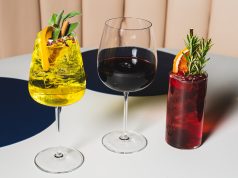
Judging by Boulder County menus, wine shelves and conversations, the only two red grapes that matter from Italy are nebbiolo and sangiovese. The only regions that matter for reds, it seems sometimes, are Piedmont and Tuscany.
Tuscan wines like Chianti, brunello di Montalcino, super Tuscans and others have been, rightfully, afforded elite status. Nebbiolo, often seen in wine from Barolo and Barbaresco, is considered a more challenging grape, but still many hold it in the highest regard. Take this introduction from Frasca’s wine list — a James Beard Awardwinning wine list — as an example of the esteem with which many hold the grape.
“Nebbiolo is Italy’s greatest red grape,” the menu reads. “There is a taut crispness in the mouth, an aristocratic reticence even, particularly when compared to the palate shape of plush super Tuscans or the full-throttle reds of the New World.”
Far be it from me to dispute that. I don’t know how, and I’m scared to. But in that due bluster around nebbiolo and sangiovese, and their subsequent products, it’s hard to find on Boulder County menus what some of us hiding over in the corner consider Italy’s finest red: amarone della Valpolicella.
Amarone is a dry red wine made from a majority of the corvina grape blended with up to 30 percent rondinella and up to 25 percent of other varietals, often molinara. Valpolicella is a wine region that lies in the hills outside Venice in the northeast Italian region of Veneto.
Amarone is considered a vino da meditazione, or meditative wine, because it’s often consumed toward the end of meals, as festivities begin to wind down. It can be imbibed with sharp cheeses, roasts or gamey meats, or just enjoyed on its own. It can be legally no less than 14 percent alcohol, and it has a raisiny sweetness, low acidity and a full body.
The process by which amarone, which means “the big, or great, bitter,” is made is labor intensive and perilous for the winemaker. In October, winemakers hand-pluck bunches of grapes that have grown with space in between the fruits. The bunches are then laid in the same direction on, typically, straw or bamboo mats called arelle, though now plastic trays are often used for the sake of quality. Winemakers pick off moldy, unripe and unwanted grapes from the vines. The skins are given special attention as they add much of the color and structure to the wine. They are left to dry until at least January according to law. Many winemakers now do this in climate-controlled facilities to minimize loss, but some still do it without the aid of technology. The drying process can last longer to increase aromas, and it is critical in the process that moisture is wicked from the grapes (this is often accomplished by the bamboo sheets).
The wine is then carefully pressed and slowly fermented for one to two months and put into barrels for an aging process that can be no shorter than three years.
The resulting wine is bottled and should be enjoyed seven to 10 years after the date. I was able to pick up two excellent, cheaper amarones at a local liquor store this week, each for about $30 (heavily on sale): a 2007 Corte Del Sol and a 2007 Le Bessole, which didn’t open up for three full hours.
If your interest is piqued, go snatch those up — or you can grab a recioto, which is a sweeter amarone made by prematurely stopping the fermentation process. Or there are a number of excellent Valpolicella ripasso wines, which is where wine from the region is passed over the skins and pomace of amarone — you’ll get a tannic, interesting wine that varies depending on the maker.














